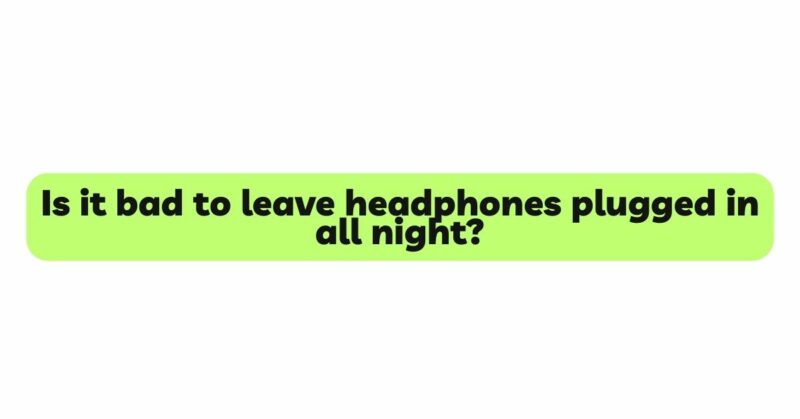As wireless headphones become increasingly popular, users often wonder about the best practices for charging and maintaining their devices. One common question that arises is whether it is bad to leave headphones plugged in all night. In this article, we delve into the potential impact of leaving headphones plugged in for extended periods, the effect on battery health and performance, and recommended charging practices to ensure long-lasting, reliable headphone performance.
- Understanding Lithium-ion Batteries in Headphones:
Most modern wireless headphones are equipped with lithium-ion (Li-ion) batteries, known for their high energy density, lightweight design, and reduced self-discharge rates. Li-ion batteries have become the standard choice for portable electronic devices due to their improved performance and safety compared to traditional nickel-based batteries. Understanding the characteristics of Li-ion batteries is crucial in determining the best charging practices for headphones.
- Leaving Headphones Plugged in All Night: The Pros and Cons
a) Pros of Leaving Headphones Plugged in All Night:
- Convenience: Leaving headphones plugged in all night provides the convenience of starting the day with a fully charged device, ready for extended use without worrying about battery levels.
- Automatic Shut-off: Many modern headphones come with smart charging circuits that automatically stop charging once the battery reaches full capacity. This feature prevents overcharging, protecting the battery from potential damage.
- Deep Sleep Mode: Some headphone models feature a low-power deep sleep mode, which activates when the battery is fully charged. This reduces energy consumption and minimizes the risk of battery damage caused by prolonged charging.
b) Cons of Leaving Headphones Plugged in All Night:
- Long-Term Battery Health: Continuous charging at 100% capacity can lead to long-term battery degradation. Over time, constant exposure to high voltage can reduce the overall capacity and lifespan of the battery.
- Heat Generation: Charging generates heat, and if headphones are left plugged in for extended periods, heat can build up and affect battery performance.
- Safety Concerns: While modern headphones incorporate safety features to prevent overcharging, there is still a small risk of electrical issues that could potentially lead to battery damage or fire hazards.
- Recommended Charging Practices:
To strike a balance between convenience and battery health, consider the following recommended charging practices for wireless headphones:
- Partial Charging: Charge your headphones partially, such as when the battery is low or around 50%, to avoid continuous exposure to high voltage and extend battery life.
- Charge Before Use: Charge your headphones before using them, rather than leaving them plugged in after they are fully charged, to prevent overcharging.
- Unplug When Fully Charged: If you choose to leave your headphones plugged in all night, unplug them once they reach full capacity to prevent overcharging.
- Charge in Moderation: Avoid excessive charging or charging too frequently, as this can contribute to battery degradation over time.
- Proper Storage: If you plan to store your headphones for an extended period, ensure they are charged to around 50% before storing them in a cool, dry place, away from direct sunlight.
- Follow Manufacturer’s Guidelines: Refer to the user manual or product documentation for specific charging recommendations provided by the headphone manufacturer.
- Factors Affecting Battery Life:
Aside from charging practices, various factors can influence the overall battery life of wireless headphones:
- Volume Levels: Playing audio at higher volume levels can consume more power, leading to faster battery drain.
- Usage Patterns: Continuous music playback, frequent phone calls, and extended use of features like noise-cancellation can also impact battery life.
- Ambient Conditions: Extreme temperatures, both hot and cold, can influence battery performance.
- Battery Health and Replacement:
Over time, battery performance may naturally degrade. If you notice a significant decrease in battery life or if the battery no longer holds a charge as it used to, consider getting the battery replaced through an authorized service center.
Conclusion:
Leaving headphones plugged in all night offers convenience, but it also raises concerns about long-term battery health and potential risks. While Li-ion batteries are more resilient to memory effect, continuous exposure to high voltage and heat can still impact battery performance and lifespan. To optimize battery health while ensuring convenience, adopt partial charging, unplug when fully charged, and follow the recommended charging guidelines. Additionally, consider usage patterns and ambient conditions that can influence battery life. By adhering to these best practices, you can enjoy extended battery life and a seamless audio experience with your wireless headphones for years to come.

